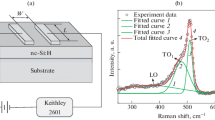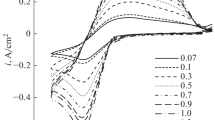Abstract
Currently, research is being actively conducted aimed at developing materials and devices for obtaining and storing energy from renewable sources. In particular, attention is paid to the conversion of solar energy with a view to its subsequent storage in lithium-ion current sources or hydrogen storage devices. In this regard, the possibility of electrochemical synthesis of photoelectroactive thin silicon films on glassy carbon from the low-melting LiCl-KCl-CsCl-K2SiF6 electrolyte at a temperature of 540 °C was studied in this article. Experimental samples of thin silicon films were obtained from the studied electrolyte depending on the electrolysis parameters; their morphology and elemental composition have been studied by means of scanning electron microscopy and energy-dispersive X-ray analysis. The pulsed mode of electrodeposition of the densest film was chosen, including: an anode treatment of the surface of the working electrode at a current density of 14.3 mA/cm2 during 5 s, after which pulsed electrolysis was carried out at a cathode current density of 28.5 mA/cm2 for 30 min with periodic current interruptions. The photoelectric effect of obtained silicon film was studied. A relatively high photosensitivity of the sample was shown due to an increased specific surface area and its energy inhomogeneity. Then, the base properties of the obtained sample were determined by means of atomic emission spectroscopy, visual photoelectron microscopy with plasma treatment of the sample with argon, laser atomic emission spectrometry, and atomic force electron microscopy.
Highlights
• Electrochemical synthesis.
• Silicon thin films were deposited.
• Films were tested.
Similar content being viewed by others
Data Availability
The authors declare that the data supporting the findings of this study are available within the article and its supplementary information are available by request.
References
Islam M, Said H, Hamzaoui A, Mnif A (2022) Study of structural and optical properties of electrodeposited silicon films on graphite substrates. Nanomaterials 12:363. https://doi.org/10.3390/nano12030363
Laptev M, Isakov A, Grishenkova O, Vorob’ev A, Khudorozhkova A, Akashev L, Zaikov Y (2020) Electrodeposition of thin silicon films from the KF-KCl-KI-K2SiF6 melt. J Electrochem Soc 167:042506. https://doi.org/10.1149/1945-7111/ab7aec
Zou X, Ji L, Ge J, Sadoway DR, Yu ET, Bard AJ (2019) Electrodeposition of crystalline silicon films from silicon dioxide for low-cost photovoltaic applications. Nat Commun 10:5772. https://doi.org/10.1038/s41467-019-13065-w
Van Ivan GD, Jef P (2023) Aluminum-induced crystallizationforthin-film polycrystallinesilicon solar cells: achievementsandperspective. Sol Energy Mater Solar Cells. https://doi.org/10.1016/j.solmat.2013.08.01
Song YJ, Anderson WA (2000) Amorphous silicon/p-type crystalline silicon heterojunction solar cells with a microcrystalline silicon buffer layer. Sol Energy Mater Solar Cells 64:241–249
Lu Zhao Q, Chen C, Li G, Shi (2007) Electrochemical fabrication of p-poly (3-methylthiophene)/n-silicon solar cells. Sol Energy Mater Solar Cells 91:1811–1815. https://doi.org/10.1016/j.solmat.2007.06.010
Strehlke S, Bastide S, Levy-Clement C (1999) Optimization of porous silicon reflectance for silicon photovoltaic cells. Sol Energy Mater Solar Cells 58:399–409
Lambertz A, Smirnov V, Merdzhanova T, Ding K, Haas S, Jost G, Schropp REI, Finger F, Raua U (2023) Microcrystalline silicon–oxygen alloys for applicationin silicon solar cells and modules. Sol Energy Mater Sol Cells. https://doi.org/10.1016/j.solmat.2013.05.053
Li P, Wanga K, Ren S, Jianga D, Shia S, Tana Y (2018) Microstructure and conversion efficiency of multicrystalline silicon ingot prepared by upgraded metallurgical grade silicon. Sol Energy Mater Sol Cells 186:50–56
Klyuia NI, Litovchenko VG, Rozhin AG, Dikusha VN, Kittler M, Seifert W (2002) Silicon solar cells with antireflection diamond-like carbon and silicon carbide films. Sol Energy Mater Solar Cells 72:597–603
Roca F, Sinno G, Di F, Procini P, Fameli G, Grillo P, Citarella A, Pascarella F (1997) Process development of amorphous silicon/crystalline. Sol Energy Mater Solar Cells 48:15–24
Selj JH, Thøgersen A, Foss SE, Marstein ES (2010) Optimization of multilayer porous silicon antireflection coatings for silicon solar cells. J J Appl Phys 107:074904. https://doi.org/10.1063/1.3353843
Suzdaltsev A (2022) Silicon electrodeposition for microelectronics and distributed energy: a mini-review. Electrochem 3:760–768. https://doi.org/10.3390/electrochem3040050
Kosov A, Semerikova O, Vakarin S, Grishenkova O, Trofimov A, Leonova N, Leonova N, Zaikov Y (2021) Photovoltaic response of silicon wafers treated in the K2WO4-Na2WO4-WO3 melt. J Electrochem Soc 168:126503. https://doi.org/10.1149/1945-7111/ac3a28
Bubenchikov A, Nurakhmet Y, Molodikh V, Rudenok A (2016) Solar power as sources of electrical energy. Int Res J 5:59–62. https://doi.org/10.18454/IRJ.2016.47.288
Li M, Zhong D, Ma T, Kazemian GW (2020) Photovoltaic thermal module and solar thermal collector connected in series: energy and exergy analysis. Energy Conv Manag 206:112479. https://doi.org/10.1016/j.enconman.2020.112479
Roger J, Schorn L, Heydarian M, Farag A, Feeney T, Baumann D, Hu H, Laufer F, Duan W, Ding K, Lambertz A, Fassl P, Worgull M (2022) Laminated monolithic perovskite/silicon tandem photovoltaics. Adv Energy Mater 12:2200961. https://doi.org/10.1002/aenm.202200961
Akbulatov A, Frolova L, Dremova N, Zhidkov I, Martynenko V, Tsarev S, Luchkin S, Kurmaev E, Aldoshin S, Stevenson K, Troshin P (2020) Light or heat: what is killing lead halide perovskites under solar cell operation conditions? J Phys Chem Lett 11:333–339. https://doi.org/10.1021/acs.jpclett.9b03308
Kuchmizhak A, Il’yaschenko V, Sergeev A, Gerasimenko A, Gutakovskii A, Mitsai E, Amosov A, Shevlyagin A (2022) Mg2Si is the new black: introducing a black silicide with > 95% average absorption at 200–1800 nm wavelengths. Appl Surf Sci 602:154321. https://doi.org/10.1016/j.apsusc.2022.154321
Sofia S, Wang H, Bruno A, Cruz-Campa J, Buonassisi T, Peters I (2020) Roadmap for cost-effective, commercially-viable perovskite silicon tandems for the current and future PV market. Sustain Energy Fuels 4:852–862. https://doi.org/10.1039/c9se00948e
Liu K, Chen B, Yu Z, Wu Y, Huang Z, Jia X, Li C, Spronk D, Wang Z, Wang Z, Qu S, Holman Z, Huang J (2022) Reducing sputter induced stress and damage for efficient perovskite/silicon tandem solar cells. J Mat Chem A 10:1343–1349. https://doi.org/10.1039/D1TA09143C
Dunfield S, Moore D, Klein T, Fabian D, Christians J, Dixon A, Dou B, Ardo S, Beard M, Shaheen S, Berry J, Van Hest M (2018) Curtailing perovskite processing limitations via lamination at the perovskite / perovskite interface. ACS Energy Lett 3:1192–1197. https://doi.org/10.1021/acsenergylett.8b00548
Ishikawa R, Watanabe S, Yamazaki S, Oya T, Tsuboi N (2019) Perovskite / graphene solar cells without a hole-transport layer. ACS Appl Energy Mater 2:171–175. https://doi.org/10.1021/acsaem.8b01606
Schmager R, Roger J, Schwenzer J, Schackmar F, Abzieher T, Byranvand M, Nejand B, Worgull M, Richards B, Paetzold U (2020) Laminated perovskite photovoltaics: enabling novel layer combinations and device architectures. Adv Funct Mater 30:1907481. https://doi.org/10.1002/adfm.201907481
Werner J, Niesen B, Ballif C (2017) Perovskite/silicon tandem solar cells: marriage of convenience or true love story? –An overview. Adv Mat Interfaces 5:1700731. https://doi.org/10.1002/admi.201700731
Gevel TA, Zhuk SI, Suzdaltsev AV, Zaikov YuP (2022) Study into the possibility of silicon electrodeposition from a low-fluoride KCl-K2SiF6 melt. Ionics 28:3537–3545. https://doi.org/10.1007/s11581-022-04573-9
Zhuk S, Isakov I, Apisarov A, Grishenkova O (2017) Electrodeposition of continuous silicon coatings from the KF-KCl-K2SiF6 melts. J Electrochem Soc 164:H5135–H5138. https://doi.org/10.1149/2.0171708jes
Xie H, Zhao H, Liao J, Yin H (2018) Electrochemically controllable coating of a functional silicon film on carbon materials. Electrochim Acta 269:610–616. https://doi.org/10.1016/j.electacta.2018.03.002
Yasuda K, Nohira T (2022) Electrochemical production of silicon. High Temp Mater Process 41:247–78. https://doi.org/10.1515/htmp-2022-0033
Gevel TA, Zhuk SI, Leonova NM, Leonova AM, Suzdaltsev AV, Zaikov YuP (2022) Electrodeposition of silicon from the KCl-CsCl-K2SiF6 melt. Rus Met (Metally) 2022:958–964. https://doi.org/10.1134/S0036029522080237
Padamata SK, Saevarsdottir G (2023) Silicon electrowinning by molten salts electrolysis. Front Chem 11:1133990. https://doi.org/10.3389/fchem.2023.1133990
Abdurakhimova R, Laptev M, Leonova N, Leonova A, Schmygalev A, Suzdaltsev A (2022) Electroreduction of silicon from the NaI-KI-K2SiF6 melt for lithium-ion power sources. Chim Tech Acta 9:20229424. https://doi.org/10.15826/chimtech.2022.9.4.24
Gevel T, Zhuk S, Leonova N, Leonova A, Trofimov A, Suzdaltsev A, Zaikov Yu (2021) Electrochemical synthesis of nano-sized silicon from KCl-K2SiF6 melts for powerful lithium-ion batteries. Appl Sci 11:10927. https://doi.org/10.3390/app112210927
Ustinova Y, Pavlenko О, Gevel T, Zhuk S, Suzdaltsev A, Zaikov Y (2022) Electrodeposition of silicon from the low-melting LiCl-KCl-CsCl-K2SiF6 electrolytes. J Electrochem Soc 169:032506. https://doi.org/10.1149/1945-7111/ac5a1c
Pavlenko OB, Ustinova YuA, Zhuk SI, Suzdaltsev AV, Zaikov YuP (2022) Silicon electrodeposition from low-melting LiCl-KCl-CsCl melts. Rus Met (Metally) 2022:818–824. https://doi.org/10.1134/S0036029522080109
Parasotchenko YuA, Pavlenko OB, Suzdaltsev AV, Zaikov YuP (2023) Electrochemical nucleation of silicon in the low-temperature LiCl-KCl-CsCl-K2SiF6 melt. J Electrochem Soc 170:022505. https://doi.org/10.1149/1945-7111/acbabf
Nikolaev A, Mullabaev A, Suzdaltsev A, Kovrov V (2021) Purification of alkali metal chlorides by zone recrystallization for use in operations of pyrochemical processing of spent hydrocarbon fuel. At Energ 131(4):199–205. https://doi.org/10.1007/s10512-022-00865-5
Zaykov YP, Zhuk SI, Isakov AV, Grishenkova OV, Isaev VA (2015) Electrochemical nucleation and growth of silicon in the KF-KCl-K2SiF6 melt. J Solid State Electrochem 19:1341–1345. https://doi.org/10.1007/s10008-014-2729-z
Acknowledgements
The equipment of Shared Access Centers «Modern nanotechnology» (Ural Federal University) and «Composition of compounds» (Institute of High-Temperature Electrochemistry UB RAS) was used in this study. The authors thank Natalia Leonova for determining the photoelectric effect of the silicon sample. This work was carried out in the frame of the State Assignment number 075-03-2023-006 dated 16.01.2023 (the theme number FEUZ-2020-0037).
Author information
Authors and Affiliations
Contributions
Olga B. Pavlenko was involved in obtaining precipitation, conducting analyzes and writing the original text. Andrey V. Suzdaltsev was engaged in setting the research problem and correcting the text of the article. Yulia A. Parasotchenko was engaged in determining the parameters of electrodeposition. Yury P. Zaikov was responsible for scientific management. All authors reviewed the manuscript.
Corresponding author
Ethics declarations
Ethical Approval
Not Applicable.
Consent for Publication
All the authors of the manuscript mutually agree on submission and publication in the journal.
Consent to Participate
All Authors contributed to the work and revised the manuscript.
Competing Interests
The authors declare no competing interests.
Additional information
Publisher’s Note
Springer Nature remains neutral with regard to jurisdictional claims in published maps and institutional affiliations.
Electronic Supplementary Material
Below is the link to the electronic supplementary material.
Rights and permissions
Springer Nature or its licensor (e.g. a society or other partner) holds exclusive rights to this article under a publishing agreement with the author(s) or other rightsholder(s); author self-archiving of the accepted manuscript version of this article is solely governed by the terms of such publishing agreement and applicable law.
About this article
Cite this article
Pavlenko, O.B., Suzdaltsev, A.V., Parasotchenko, Y.A. et al. Electrochemical Synthesis and Characterization of Silicon thin Films for Energy Conversion. Silicon 15, 7765–7770 (2023). https://doi.org/10.1007/s12633-023-02615-z
Received:
Accepted:
Published:
Issue Date:
DOI: https://doi.org/10.1007/s12633-023-02615-z




